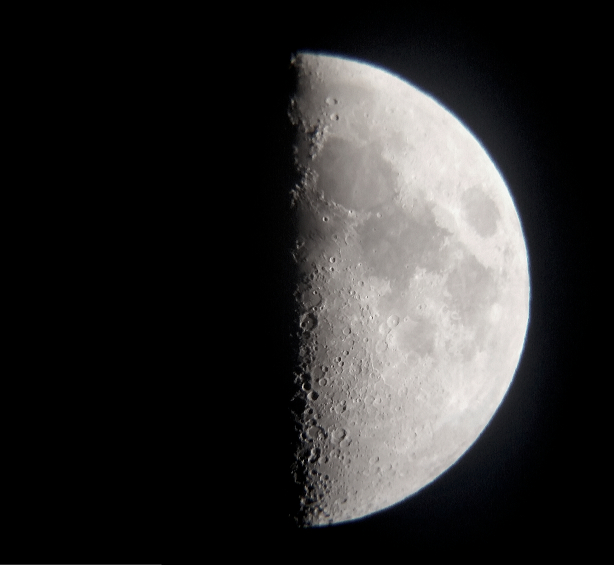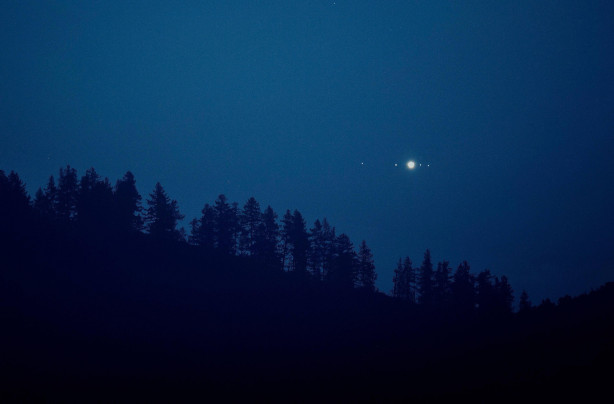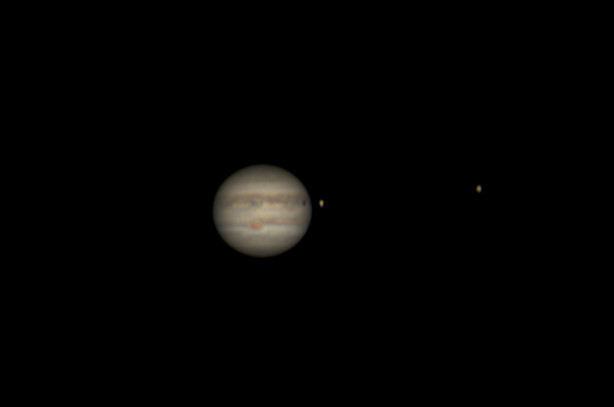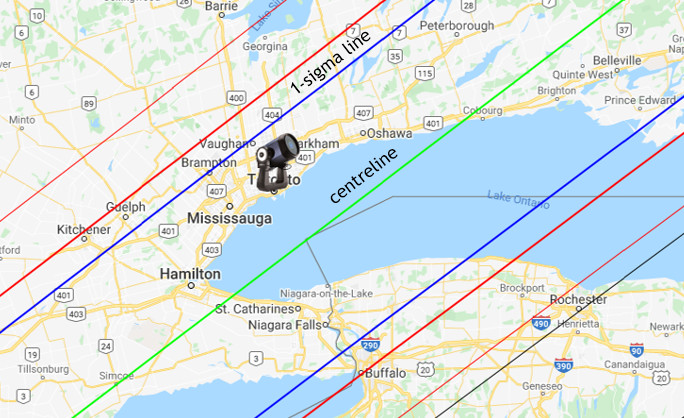The Sky This Month Aug-Sep 2020
With comet C/2020 F3 fading fast, we can return to Jupiter and Saturn, which continue to offer stunning views. Neptune is close to the Earth on 10 Sep and we are slowly closing in on Mars. For Aug-Sep 2020, we'll follow the meridian from south to north for an excellent sampler of deep sky objects.
preamble
Blake Nancarrow delivered an online presentation of The Sky This Month on 19 August 2020. He prepared his usual month-at-a-glance calendar covering the period. You may view or download and print the colour calendar PDF file.
- TSTM 202008 calendar, 440 KB, PDF
All these materials accompany the live stream and recorded video available on the RASC Toronto Centre YouTube channel.
All photos and graphics copyright the respective owners.
If you are working on a RASC observing programme (perhaps to achieve a certificate), we include targets from Explore The Universe, Explore the Moon, Messier, and the RASC Finest NGCs. See the RASC Visual Observing Programs page for more information. We also refer to Herschel 400 and Halton Arp objects. Many details of objects and events and phenomena are noted in the RASC Observer's Handbook.
observing lists
The suggested targets for this TSTM were collated into observing lists for a couple astronomy software apps with planning capabilities. You may download a file and install it in your device or computer so to have a list of suggestions when at the telescope or otherwise outside.
- SkySafari: TSTM202008.skylist, 10 KB, text
- SkyTools version 3: TSTM202008_st3.stx, 1 KB, binary
(ST3 files can be imported into ST4) - Excel: TSTM202008.xls, 18 KB, binary
Note: Files stored on Blake's web site under the Computer Ease domain.
The SkySafari list does not include the quasar PHL 1811 but a nearby Tycho star is used for star hopping. See Stefan Karge's web page for more information on the quasar.
Sun
Our Sun is in the constellation of Leo for the entire reporting period, from 19 Aug to 16 Sep 2020. We're on the steep slope of the day-night hourglass with the days getting shorter and the nights getting longer.
19 Aug
- sunset 8:10 PM, twilight ends 10:00 PM
- twilight begins 4:40 AM, sunrise 6:30 AM
- that's about 6.5 hours of darkness
16 Sep
- sunset 7:20 PM, twilight ends 9:00 PM
- twilight begins 5:20 AM, sunrise 7:00 AM
- 8.0 hours of darkness
For dates and times, visit the Time and Date web site's Toronto page.
The Sun might be waking up from it's long slumber. An interesting large sunspot was detected in late July. Keep an eye on the Space Weather web site for things happening on or near the Sun.
Moon
The main Moon phases are:
- 18 Aug (yesterday): new Moon
- 25 Aug: 1st quarter
- 2 Sep: full Moon
- 10 Sep: 3rd quarter
- 17 Sep: new Moon
The Lunar X clair-obscur effect may be observed with a small or larger telescope on 25 Aug. See the article at Wikipedia for more information.

It is predicted to start at 6:10 PM. The sky will still be bright then but try the trick of wearing sunglasses to look at the Moon. Or use a polariser filter in your telescope or on your camera lens. The X event should peak around 8:30 PM which is after sunset in a darker sky. The X will disappear around 10:50 PM. The Moon will be reasonable high at an elevation of 24°.
Try the Dial-a-Moon web site then enter the date and universal time to see how the Moon will look based on high-quality imagery from NASA.
The Straight Wall or Railroad will be visible one day later. You are less constrained by time with this feature and should be able to observe it any time. This stark shadow from Rupes Recta is caused change in elevation between an upper plane and lower plane, similar to our Niagara Escarpment. The linear fault is in the southeastern part of the Mare Nubium, is about 110 km long with a height of 240 to 300 metres.
The Moon will be positioned nicely between Pleiades and Hyades on 8 Sep.
Mars
Mars is getting bigger and brighter.

The fourth rock from the Sun will grow from 17 to 21 arc-seconds and brighten from magnitude -1.5 to -2.2. While opposition is still about a month away, it is interesting to look at, and easy to view. Rise times are improving to: Aug, 10:30 PM; then in Sep, 8:30 PM.
The red planet will seem to stop moving against the background stars on 9 Sep. The normal (prograde) motion, west to east, across the sky slows and stops as the Earth on the inner track moves more rapidly than Mars. Retrograde motion will start on 10 Sep and continue into November. See the infographics at the When The Curves Line Up blog.
Surface features on Mars will reveal themselves in the coming months. Perhaps the tiny moons Phobos and Deimos will be visible to the advanced astronomer or imager.
Three spacecraft on their way to Mars, from three different nations, with interesting mission objectives. They will all arrive February 2021.
Jupiter
Not that it was a bad thing but that comet distracted us from the gas giants in the opposite part of the sky.

While Jupiter went through opposition on 14 Jul, it is still putting on an amazing show. There are so many events in fact that the author did not list them on his month-at-a-glance calendar. Invariably, on any given night in the next four weeks, if you look at the biggest planet in the solar system, you should see something interesting.
There will be many Great Red Spot (GRS) crossings at the meridian, the imaginary line straight through the middle of Jupiter, from it's north through south poles.
There will be numerous moon events, with the four large and bright Galilean bodies. There will be moon transits where the moon passes in front of the planet. Typical they disappear from view at these times. But these moons, due to the angle of the Sun and Earth, will cast shadows. A moon shadow transit is easy to see in the telescope as the inky black dot moves across the cloud tops. We can observe occultations where the moon goes behind the big oblate shape of Jupiter, literally where Jupiter blocks our view of the Moon. The contact events are fun where the planet will appear with a bump or little mound. And we'll be able to enjoy eclipses. These occur when a moon moves into or emerges from the huge shadow cone behind Jupiter. It's startling when a tiny moon suddenly disappears or unexpectedly pops into view.

If using software to predict GRS events, ensure it is accurate and consistent. It was recently found that Stellarium is not properly showing the GRS positions. SkySafari updates automatically and appears correct. Once the up-to-date longitude is entered in SkyTools and StarryNight, you will see the proper position. Check the GRS longitude at the JUPOS site. Use the Sky & Tel Javascript web site tools to corroborate the view.
Noted below are "interesting" events where two or more things are happening consecutively or simultaneously. Particularly special events are marked with asterisks.
For August:
- 19, starts early eve: Europa emerges from eclipse, Callisto from occultation, Great Red Spot transit (GRS), 4 on one side, Io passes Europa ****
- 21, 11 PM thru set: GRS, double transit, one shadow
- 22, 8 PM thru set: GRS, Io occulted, Io from eclipse
- 23, 9 PM: Io transit, Io shadow
- 24, rise thru set: Io from eclipse, Io passes Europa, GRS, Europa transits, shadow
- 26, from 11 PM: Europa from eclipse, 4 on one side, GRS
- 28, Earth's Moon nearby
- 29, rise to set: 4 on one side, GRS, Europa passes Ganymede, Io occulted
- 31, around 10 PM: Io from eclipse, GRS, Io passes Europa, Earth's Moon is full
September:
- 1, rise: Io transit and shadow in progress, Ganymede now you see it now you don't, Great Red Spot (GRS) transit, oh, Ganymede's back! ****
- 4, 9 PM: flanking pairs, Io and Ganymede may merge, Europa and Callisto merge
- 5, from 8:30 PM: Callisto eclipsed, GRS, Callisto reappears
- 7, rise thru midnight: Io occulted, Io from eclipse, GRS, Io passes Europa
- 8, rise to 1 AM: Io transit and shadow in progress, Ganymede occulted, GRS, Ganymede appears, Ganymede eclipsed ****
- 9, 11 PM to set: Io from eclipse, Europa occulted, GRS
- 12, rise to 11 PM: Ganymede shadow transit in progress, Io and Ganymede merge, GRS
- 13, rise thru set: Callisto transit in progress, GRS, Io and Europa merge
- 15, 8 PM to 11: Io transit and shadow, GRS, Io and Ganymede merge, 4 on one side, Ganymede occulted ****
You don't need a telescope to enjoy Jupiter. Get out the binoculars and steady or stabilise them. You will see the moons dance around Jupiter night-by-night like astronomer Galileo did. You can easily photograph Jupiter with a long lens and tripod to capture the fascinating alignment of moons and planet.
Saturn
The ringed planet was opposite the Sun a month ago. While below ecliptic, it too is still making for fantastic views. The rings are obvious and the big moon Titan should be easy. Try for more challenging features of Saturn. Can you see the Cassini Division? Can you see the other moons such as Rhea, Dione, and Enceladus? Can you see the different colours of cloud bands on the planet.
The advanced astronomer can attempt moon Mimas. This was discovered in 1789 by William Herschel with a huge telescope! It will be tough for mere mortals with amateur instruments at magnitude 13.1. It is 17" from planet which keeps it very close to the rings. Mimas's orbital period is about 1 day. And it is small with a diameter of 400 kilometres. Probably the best time to try to see this little world will be during elongations, when it is at the extreme east or west part of its orbit. Use the plotting tools from SETI.
Neptune
One of the ice giants is visible for telescope users, at over 4 light-hours distance.
Neptune reaches opposition on 10 Sep so will be visible all night. It will be small, 2.3", for certain but at magnitude 7.8, it will be detectable in binoculars. Even though 29 astronomical units (AU) away (or 4.4 billion km), it is obvious and colourful in the telescope! And even at that extreme distance, its moon Triton is surprisingly easy.

Look east of φ (phi) Aquarii. It's almost exactly in the middle between stars φ and HR 8024.
Triton is mag 13.5, up to 17" from the planet. Again, best viewing opportunities are during maximum elongations. In September, they occur on:
- 5 at 2:30 AM: northern
- 8 at 1:00 AM: southern
- 10 at 11:45 PM: northern
- 13 at 10:00 PM: southern
Felicitas occultation
We might have a fairly easy asteroid occultation in August. (109) Felicitas will occult star UCAC4 596-023101 in Auriga. This star has a V filter magnitude of 12.5.

The event universal time is Fri 21 Aug 2020 08:17:47. Subtracting 4 hours means 4:17 AM local time (ugh). The rank is very high, 100. The mag drop is not huge at 1.2. The predicted duration is 2.4 seconds.
The path is right over the Prince Edward county and the Greater Toronto Area (GTA). Peterborough, Oshawa, Markham, Scarberia, Toronto, Mississauga, Oakville, Burlington, Hamilton, Tillsonburg, etc. are all between the centre-line and the 1-sigma boundary to the north. Fire up the video camera and GPS!
See Steve Preston's list for more information and charts.
flyovers
The International Space Station flys over Toronto in the mornings (pre-dawn) between 24 Aug to 14 Sep. Then passes immediately shift to evenings (after sunset). Visit the Heavens Above web site for more information and charts for your specific location. The brightest passes are:
- 26 Aug at mag -2.8
- 29 Aug at -3.8
- 30 Aug at -2.7
- 31 Aug at -3.3
- 9 Sep at -3.2
- 11 Sep at -3.7
- 12 Sep at -3.8
- 17 Sep at -3.8
deep sky targets
Let's try something complete different. Let's travel along the meridian at 11 PM in late August, starting in the south, moving through the zenith overhead, and continue to the north, through Polaris.
We will encounter constellations, asterisms, galaxies, planetary nebula, globular and open clusters, double, variable, and red stars, a supernova remnant, some diffuse nebula, planets, and a quasar. There will be subjects for the beginner, intermediate, and advanced observer. Targets for visual astronomy and photographic capture. Go!

For the experienced astronomer, it's time to learn a new constellation. Visit Microscopium as it clears the southern horizon in Ontario. While there are no big and bright galaxies here, there are a few interesting double stars.
View α (alpha) Microscopii aka HJ 5224. It's the "main" star for the microscope constellation but not the lucida. beta and gamma are brighter. They are bright enough to be spotted with the unaided eye. These stars will be 12 degrees above the horizon so you must have a good sight-line.
Alpha Mic is an double. The primary is magnitude 4.9 with the secondary 20" away at mag 10.
Up and right we will spot Jupiter and Saturn are in Sagittarius left of the Teapot asterism.
If you didn't look at all the interesting Messier and NGC objects in Scorpius and Sagittarius, all near the centre of the galaxy, you better hurry. They are all setting.
Messier objects M55 and M75, both globular clusters, are also in the constellation of the Archer. Globulars are dense compact spherical groupings of stars, millions or billions of stars. There appear to be hundreds of globulars surrounding the Milky Way galaxy, like bees around the hive.
Little Gem aka NGC 6818 is a planetary nebula, the outcome of an old and dying star. This object is a RASC Finest NGC target.
We have the interesting double star/variable star groups, Dabih aka STF A 52 and Al Giedi / Secunda Giedi aka HJ 608 in Capricornus, the constellation that looks like a bat. Both of these are in the Explore the Universe observing program. Use every level of magnification, from the Mark I eyeball, to binoculars, low power telescope view, and high power. The wide easy naked eye double will split into many tight pairs.
Way over past the east wing of the bat is an easy quasar for people in an 8" or larger telescope. PHL 1811 was found in the Palomar-Haro-Luyten survey. This quasi-stellar object is also known as QSO J2155-0922. It shines at magnitude 13.9. Look 1/3 of a degree west-north-west of star HD 208421 aka SAO 145755. The redshift z value is 0.192. The distance is estimated at 745 Mpc or a little more than 2 000 000 000 light-years.
Saturn Nebula is near ν (nu) Aquarii, aka NGC 7009, an curiously-shaped planetary nebula. Another Finest NGC, it is also in the Herschel 400 list.
We will scoot past Aquila and Equuleus.
Pausing at the Dolphin will reveal the amazing double stars of Sualocin aka α (alpha) Delphini, γ (gamma) 2 Del, and Rotanev or β (beta), all in the head of the porpoise.
Globular M71 is in nearby in little Sagitta.
If you're using low power, you might spot Collinder 408 nearby, to the south, a misting of stars, a small open cluster, aka Harvard 20 and OCL 116.
Beyond is the big Cr 399 aka Brocchi's Cluster affectionately known as the Coathanger. Use very low power or binoculars. Can you see it naked eye? It should be easy in a dark site. It is at the edge of visibility in a semi-rural location.
Asteroid Pallas moved through this region in mid-June.
The Dumbbell or Apple Core aka M27 is also in Vulpecula, a rather large planetary. Use low power. Try an ionised oxygen filter if you have one.
Open cluster NGC 6885 is not far away. It's a Herschel target.
We could spend hours in Cygnus and it harbours many famous objects but very near our path is the West Veil Nebula, a Finest target, also known as NGC 6960, one part of a large supernova remnant. View in dark skies with low power and an O-III filter.
It is so large, photographers often need to assemble a mosaic from multiple images.
From very dark skies, can you see the diffuse North American Nebula with the unaided eye? It's very near Deneb and a popular target for the wide-field imager.
Another RASC Finest NGC is not far away, the Blinking Planetary or NGC 6826, where you can practice your averted vision techniques.
Measure R Cygni, a Mira-type variable that ranges between magnitude 6 and 14 (most of the time) over 426 days. It is a rare S-type "metallic" star, with the first recorded observation in 1852.
We will skirt the border between Cepheus and Draco in our journey.
Do a naked eye assessment of variable star δ (delta) Cephei comparing against ζ (zeta) and ε (epsilon).
Also have a gander at μ (mu) Cephei aka the Garnet Star, it's orange or red star.
Both delta and mu are doubles that will reveal their companions in the telescope.
Thought mu was red? Try for challenging S Cephei. It is an astonishingly colourful carbon star.
We will soon encounter Polaris, near the end of our celestial trip, if you didn't start with it at the beginning of your evening. Did you know alpha Ursae Minoris is a double star?
Very near Polaris, in Cepheus, is challenge object NGC 2276. It is noted in the Astronomical League's "two in the view" galaxy list for it is beside NGC 2300. Also found in the Arp catalogue, number 25. You might need a 14" aperture. Or a sensitive camera.
If you can see the north sky below Polaris, you could have a look at two galaxies in the Great Bear, M81 and M82, Bode's and the Cigar, respectively. Not the best time of the year to view them but hey!
We'll stop with the nose. The snout of the Great Bear is star Muscida or ο (omicron) Ursae Majoris.
summary
Lots of thanks are due. Tools used to compile information and make info-graphics include SkyTools, Stellarium, SkySafari, OccultWatcher. Thanks to Betty, Andrew, Ward, and Ennio for video streaming and recording. Thanks to Zoom and YouTube and OBS during these "interesting" times! The QR code was quickly produced with https://www.qr-code-generator.com/. Much data was copied from David Mitsky's monthly report, Ron Baalke's space flight web site, the RASC Observer's Handbook and 2020 Calendar. SkyNews and Sky & Telescope magazine resources were consulted. Websites JUPOS.org and the Ring-Moon Systems Node. I thank the NASA and ESA agencies. Claudio Oriani offered the Jupiter image. Tanya Oleksuik provided the Lunar X photograph. The Mars image was provided by Team dos Santos. I thank Jeffrey Hunt and Chris Vaughan for additional data.
See the author's lumpy darkness blog for astronomy information, astrophotos, tips and tricks, guides and videos on astronomy software, and so on. Contact Blake Nancarrow (astronomy at computer-ease dot com) for errors, omissions, questions.
Be seeing you (online).

